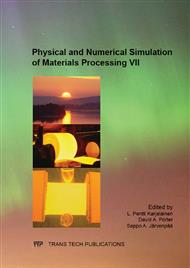p.649
p.656
p.662
p.668
p.673
p.680
p.686
p.691
p.699
Evaluation of the Fatigue Life in Aluminum Alloy Welded Joint by Nonlinear Ultrasonic Testing
Abstract:
Fatigue is a common phenomenon in welded structures. Prediction of fatigue life of welded joints in-service is still an unsolved puzzle by the conventional linear ultrasonic testing method. However, the nonlinear ultrasonic waves or the acoustic nonlinear signal can provide clear signs of the accumulative fatigue damage in materials, as reported by a number of researchers. Hence, the nonlinear ultrasonic testing method has revealed a tremendous potential for fatigue damage evaluation. This paper presents a study to characterize the fatigue damage using the analysis of the signal characteristics and a new nonlinear parameter. Based on the very high-cycle fatigue testing results for a 6N01 aluminum alloy welded joint, the relationship between the amplitude of the second-order harmonic and fatigue cycling has been established. The nonlinear ultrasonic system test results show that the amplitude of the second-order harmonic increases at the early fatigue stage, with further increase in cyclic loading until reaching a peak. Metallographic examinations show that a fatigue crack will nucleate in the weld joint in the stage as the amplitude reaches the peak value. Finally, theoretical and experimental results confirm that the amplitude of the second-order harmonic is useful for assessing the fatigue life of a 6N01 aluminum alloy welded joint.
Info:
Periodical:
Pages:
673-679
Citation:
Online since:
July 2013
Authors:
Price:
Сopyright:
© 2013 Trans Tech Publications Ltd. All Rights Reserved
Share:
Citation:


